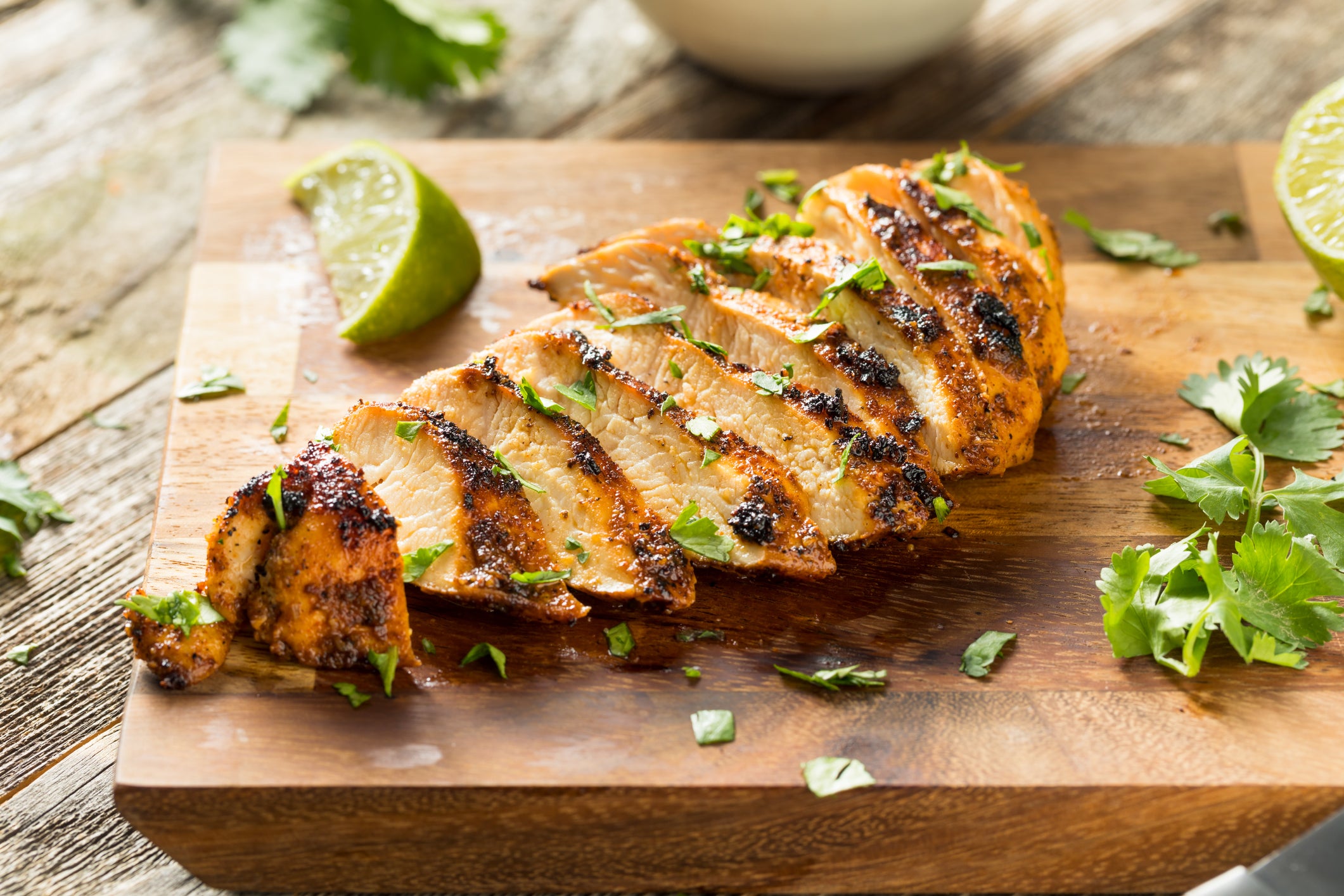The fake meat debate: Are vegetarian substitutes healthier than the real deal?
While one in five people have reduced their meat intake, nutritionists tell Saman Javed there is more that needs to be done before vegetarian alternatives can compete with the real thing


By now, environmental experts across the world are in agreement that the meat industry is contributing to the climate crisis. Industrial meat is one of the biggest causes of deforestation globally, with the UN’s Food and Agricultural Organization finding that over the past 25 years, forests have been cleared from an area the size of India for cattle ranching. In the UK, analysis from Green Peace shows that if we want to avoid a climate breakdown by 2030, we need to reduce the amount of meat we consume by at least 70 per cent.
Awareness of the issues associated with large-scale meat consumption is growing. The findings of a survey by The Vegan Society, published in May, found that one in five people have reduced the amount of meat they are eating in the last 12 months. Of those who have cut back on their meat intake, 35 per cent said they were motivated by health concerns, while 30 per cent said the environment was their primary motivation. Additionally, one in four people said they had reduced their meat intake because of animal rights issues.
Undoubtedly, one of the reasons it has become so much easier to switch out meat from our diets is the rise of meat substitutes, which are increasingly easier to find in both supermarkets and restaurants. Let’s not forget the nationwide frenzy when Greggs announced the launch of its vegan sausage roll, or the launch of the US’ highly-favoured Beyond Meat to UK supermarkets earlier this year.

While some meat substitute makers like Linda McCartney and The Unbelievable Alt market their products by championing their positive impact on the environment, other major retailers such as Quorn and Beyond Meat also use health claims in their marketing. Quorn says its products are packed “with delicious, nutritious protein” and that health is “at the heart” of what it does. Beyond Meat claims that its burgers provide an “excellent source of protein and 35 per cent less total and saturated fat” than a regular burger.
Although the environmental benefit of swapping out your Sunday roast for a Quorn chicken-style fillet is a no-brainer, questions remain about whether the meat substitutes we have come to love are actually healthier than eating real meat.
Most experts agree that meat substitutes can be a nutritious alternative, but it depends on what they are made from. Dr Stacey Lockyer, a senior nutrition scientist at the British Nutrition Foundation says that while those that list vegetables, pulses, mycoprotein and soy tend to be lower in saturated fat and calories, and higher in fibre than meat, “fat and salt are often added in order to produce a taste, texture or appearance similar to meat”. This means that some may end up with a higher saturated fat or salt content than real meat.
When you go from a piece of meat to something that’s a meat alternative, you’re going from something that is a whole food to an ultra-processed food
On its website, Quorn says its mycoprotein – the main ingredient in most of its products – is made from a naturally occurring fungus through a fermentation process, similar to the way beer and yoghurt are made. Then, “we blend nutrients derived from wheat and corn with air and essential minerals...Next, we add a small amount of egg white (or potato extract in our vegan products) and shape it to form.”
In the case of its meatless fillets, mycoprotein makes up 86 per cent of the ingredients. Others include egg white, yeast extract, salt, a firming agent, onion powder, sage and sugar. All in all, one 69g fillet contains just 60 calories, 1g of fat, 6g of carbohydrates, 5g of dietary fibre, 9g of protein and 190mg of salt.
Although an organic Class A chicken breast of the same weight contains a fraction more calories (around 67), it also has 7g more protein (16g), and less than half the amount of salt (80mg). And while the amount of carbohydrates and dietary fibre in Quron’s meatless fillets is small, it is barely negligible in chicken breast (0.5g of each).
Like many of the brands offering vegetarian meat substitutes, Dutch retailer, The Vegetarian Butcher, uses a protein that is made from soy as its main ingredient. The soy protein makes up 88 per cent of its “What The Cluck” chicken-style pieces, with spices, sunflower oil and flavourings making up the rest.

The company told The Independent it also adds colourings and starch to help the product hold its shape, as well as vitamins and minerals such as B12 and iron. In comparison, 69g of “What The Cluck” chicken pieces has 97 calories, at least 30 more calories than both Quorn fillets and chicken breast. While the Vegetarian Butcher’s chicken pieces contain just a touch less salt than chicken (76mg), they have 14.6g protein –more than both Quorn fillets and chicken.
One inherent issue with meat alternatives, nutritionist Eva Humphries explains, is that “when you go from a piece of meat to something that’s a meat alternative, you’re going from something that is a whole food to an ultra-processed food”. While she stresses that not all processed foods are bad – even a tin of chickpeas is technically classed as processed as the chickpeas were previously cooked – ultra-processed foods, like meat alternatives can lack nutrients.
“Soy is a really good example,” she explains. “We take the soybean, and as we only need the protein from it, it goes through a really lengthy chemical process so that at the end of it, we have an isolated soy protein. By that time, we’ve removed all the other goodness that the soybean may have. Then, to make that protein into a meat alternative, we are having to add other ingredients and process it even further. The end product is far removed from what that food was in the first place.”
Of course, just how processed a product is will vary from one meat alternative to the next, as will the number of additives and preservatives used to make the product taste like real meat and give it a shelf-life. While Quorn is by definition a processed food, the company denies that it is “ultra-processed”. “We don’t recognise the label of ‘ultra-processed – our protein is cultivated from a natural nutritious fungus, using the age-old method of fermentation, and then steam-cooked, chilled and frozen to create Quorn products,” a spokesperson tells The Independent.
From a nutritional perspective, there’s a lot more we need to do to make meat alternatives on par with real meat
The Vegetarian Butcher told The Independent that its mission is “to make the switch to plant-based food as easy and tasty as possible”. It said it is “continuously innovating” its products’ taste, texture and nutritional value.
Another popular meat substitute is Beyond Meat’s plant-based mince, of which the primary ingredient is water, followed by pea protein. Like The Vegetarian Butcher, Beyond Meat also adds starch and flavourings, and beetroot for colour. In 69g of Tesco’s organic 15 per cent fat beef mince, there are approximately 180 calories and 13g of protein. There is virtually no salt, no carbohydrates and 10g of fat. In 69g of Beyond Meat mince, there are slightly fewer calories (164), and a little more fat (11g). There is also less protein (10g), but more carbohydrates (3g).
Despite the large number of people moving to a plant-based diet for health reasons, Humphries warns that alternatives also lack nutrients more readily available in meat. “From a nutritional perspective, there’s a lot more we need to do to make meat alternatives on par with real meat. But I’m definitely referring to high-quality meat sources, and I wouldn’t say it’s necessary to eat meat every day,” she says.
“Some meat is a good source of protein, vitamins and minerals in your diet, such as iron, zinc and vitamin B12 but we should aim to diversify and shift the balance of our protein intake towards more plant-derived protein sources, including eating more beans and other pulses (e.g. lentils), nuts and seeds,” Lockyer adds.

Looking for meat alternatives that list pulses as one of their main ingredients is one way to ensure you get as close to as many of the nutrients as you would from real meat. “As a population, we do need to, on average, consume less meat [but] we need to make sure there’s not necessarily a health halo with ultra-processed meat-alternative products as they are often higher in salt, and making sure we get a variety of plant-based protein sources to make sure we get the full range of essential amino acids we need,” Jenny Rosborough, a registered nutritionist says.
“Once you combine grains and pulses, you have a very good amino acid profile which will equal the protein profile of meat,” Cristiano Percoco, a clinical nutritional therapist adds. But even then, he agrees with Humphries that “whole foods will always be your best option”. “I wouldn’t eat too many meat alternatives, they should be used in moderation, like once a week for a treat,” he says.
While some experts believe most of the meat alternatives on the market are too processed to be considered healthier than real meat, most agree that they are a good way to cut down our overall meat consumption. If you’re after a healthy meat alternative, look for options that contain a variety of protein-packed pulses and have as little salt as possible.
Join our commenting forum
Join thought-provoking conversations, follow other Independent readers and see their replies
Comments
Bookmark popover
Removed from bookmarks